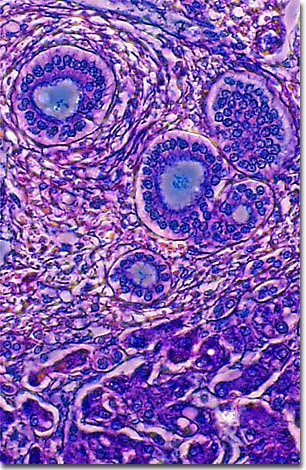Phase Contrast Image Gallery
Liver Cirrhosis
Illustrated below is a phase contrast photomicrograph of stained human liver tissue afflicted with cirrhosis. Cirrhosis is a chronic, progressive disease of the liver that can result from any number of causes.

Anything that damages liver cells can cause cirrhosis, such as chemical toxins, severe malnutrition, viruses, or metabolic disorders. Damaged or dead liver cells are replaced by fibrous scar tissue, leading to a breakdown in liver function and eventually resulting in liver failure and death. If the cause of the damage is removed early enough, the liver is capable of regenerating itself and will heal. If there is too much damage, a liver transplant may be required.
The leading cause of most cases of cirrhosis, a type called LaŽnnec's cirrhosis, is alcohol consumption. This type of cirrhosis puts over 300,000 people a year in the hospital, kills about 25,000, and is the 10th leading cause of death in the United States.
BACK TO THE PHASE CONTRAST GALLERY
